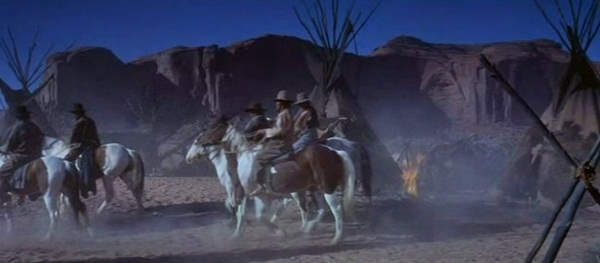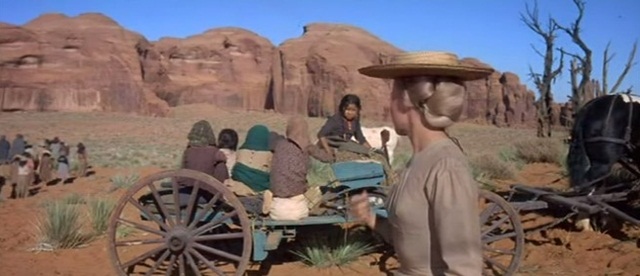

![]()
![]()
|
MAKING UP AT THE WAKE John Ford said no other director killed more native Americans in westerns than he did. In his final one, 1964’s Cheyenne Autumn, he would make up for the lack of social conscience by depressing the hell out of us about the insufferable plight this country has put the natives through and still does. As sincere as he may have been, he had neither the depth of script nor acting from his cast to measure up to his intentions, so in the end this wake is the last travelogue to his favorite locales. You keep suppressing the bitch, “How many more times must we see those same g.d. natural stone monuments?” (At 32:26 minutes into a TCM interview available on YouTube, Carroll Baker explains why.) Just when did he begin to suspect the material was a boobytrap? During the rushes about midway through? The first rough cut? He claimed to not want an intermission, ostensibly to keep the “mood” in place, but of course this runs counter to what he provided under pressure—a sequence using James Stewart as Wyatt Earp and Arthur Kennedy as Doc Holiday, in effect a brief getaway from the relentless march of gloom. There’s not a movie lover or Ford devotee who doesn’t ask, WTF? (Of the only laughs in the whole dreary enterprise, Stewart supplies two, Edward G. Robinson elsewhere the third, insufficient for recovery.) Richard Widmark does his screamer routine; Baker does her earnest thing; Karl Malden has a drunken madman exit; Robinson gets robbed of the prestige he brings when jarring if not fatal studio process shots are used for his pivotal scenes with the Indians. One of the pitfalls for older westerns had been the casting of central Indian characters—it almost never worked because we usually ended up with well-known Hispanics or sometimes bronzed numbers like Rock Hudson and Jeff Chandler sounding nutsy spieling off a nutsy-sounding lingo. Fully aware of how bigoted that reads but with Gilbert Roland, Delores Del Rio and Ricardo Montalban pattering away—not in the Cheyenne language but Navajo—it’s a peculiar truth. Peacock Sal Mineo struts sans dialogue, the wisest decision Ford makes throughout. Alex North’s score is an excessively orchestrated yet mournful rehash of Spartacus and Cleopatra, with a few feathers and tree log drums thrown in. (Intrada recently released a 2-CD set, sending the FSMers into orgasmic response, in spite of Ford’s vocal displeasure of the music.) Warner Bros promoted the depressant as a Christmas roadshow attraction, bombing hugely. Original length 170 minutes, cut to 156, then, in wide release and on TV, to 144. On DVD, it’s the 156 minute version; as separate extra, the rarely seen nineteen minute documentary Cheyenne Autumn Trail narrated by Stewart, considered and then nixed as introduction to the movie. Filmed in Super Panavision 70. (Opening 12/22/1964 at the McVickers, running 8 weeks.) Oscar nomination: best color cinematography. ROLL OVER IMAGES & POSTER


Text COPYRIGHT © 2010 RALPH BENNER (Revised 10/2016) All Rights Reserved.
|